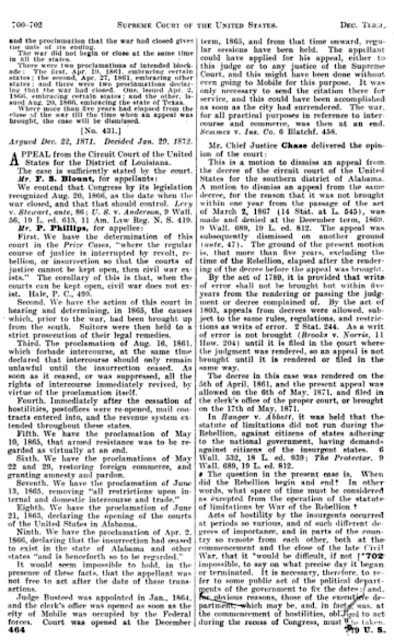It turns out the case was decided on 29 January 1872 and was known as William A. Freeborn v. The Protector, J. C. Bell. I have no idea what the original case was about, but when it reached the Supreme Court, the point of law to be decided was about statutes of limitation. My assumption is one of the parties sued the other for damages that occurred during or just after the war. The other party claimed the suit was not brought in a timely fashion due to the statutes of limitation on war damages, which would have been based on the date of the end of the war.
 |
| Page 463 from Cases Argued and Decided in the Supreme Court of the United States, Book 20, by Charles L. Thompson |
 |
| Page 464 from Cases Argued and Decided in the Supreme Court of the United States, Book 20, by Charles L. Thompson |
 |
| Page 465 from Cases Argued and Decided by the Supreme Court of the United States, Book 20, by Charles L. Thompson |
Chief Justice Salmon P. Chase delivered the opinion of the court. In that opinion, two start dates and two end dates for the Civil War were cited. They were important because the statute of limitations clock was suspended in times of rebellion and began again when rebellion ended. Justice Chase based those dates on presidential proclamations. Chase granted the appellee's motion to dismiss the case because the appeal was not filed within the time allowed by the statute of limitations.
The case seemed like a pretty trivial case about commercial law, but it did legally establish the start and end dates for the Civil War in each state and so should be a critically important case to historians. And after reading this post, you can smugly refute most history books and websites which state the Civil War started on 12 April 1861 when the Confederates fired on Fort Sumter! Based on this Supreme Court case, President Lincoln and the United States were actually the belligerent parties who started the war.
20 December 1860: South Carolina seceded
9 January 1861: Mississippi seceded
10 January 1861: Florida seceded
11 January 1861: Alabama seceded
19 January 1861: Georgia seceded
26 January 1861: Louisiana seceded
1 February 1861: Texas seceded
12 April 1861: Confederates open fire on Fort Sumter in Charleston Harbor
15 April 1861: President Lincoln issued Presidential Proclamation 80, which called up the militia
17 April 1861: Virginia seceded
19 April 1861: President Lincoln issued Presidential Proclamation 81, which ordered the blockade of ports of South Carolina, Georgia, Alabama, Florida, Mississippi, Louisiana, and Texas
 |
| Presidential Proclamation 81 as signed by President Lincoln; image courtesy of the RAAB Collection |
27 April 1861: President Lincoln issued Presidential Proclamation 82, which extended the blockade to the ports of Virginia and North Carolina
6 May 1861: Arkansas seceded
20 May 1861: North Carolina seceded
8 June 1861: Tennessee seceded
After Confederate Gen. Robert E. Lee surrendered on April 9, 1865 at Appomattox, several presidential proclamations were issued normalizing relations and commerce with the former Confederate states. However, two proclamations issued by President Andrew Johnson in 1866 were considered the formal end of the war by the Supreme Court in Freeborn v. The Protector:
2 April 1866: President Johnson issued Presidential Proclamation 153, which declared the insurrection in the states of Georgia, South Carolina, Virginia, North Carolina, Tennessee, Alabama, Louisiana, Arkansas, Mississippi and Florida to be at an end.
20 August 1866: President Johnson issued Presidential Proclamation 157, which declared peace, order, tranquility and civil authority existed throughout the United States; this proclamation was considered the official end of the war with Texas
_______________
Thompson, Charles L., Cases Argued and Decided by the Supreme Court of the United States, Book 20, Lawyers' Edition. (Rochester, New York: The Lawyers Co-Operative Publishing Company, 1918), pages 463-465
Presidential Proclamations, The American Presidency Project, University of California Santa Barbara (accessed 9 November 2015)
RAAB Collection, autograph dealers (accessed 5 November 2015)
First KIA of the Civil War
Wow. This is all news to me. I was such a fool to think I'd had a pretty good education. I learned NONE of this back in school. So glad, that as a genealogist, I've been doing some of my own digging, primarily into the American Revolutionary War, but that, too, has broadened by understanding of just what took place.
ReplyDeleteI never learned this in school either. Even though I was raised in Virginia, we were taught the Confederacy caused the war by seceding from the United States and firing on Fort Sumter. I think this is a little known case that most history books think would complicate what really happened...yet, as the highest court in the land, their ruling in my view is the official one.
Delete